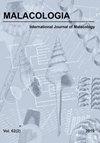Allometry in the Freshwater Pearl Mussel (Margaritifera margaritifera L.): Mussels Tend to Grow Flatter at Higher Water Speed
IF 1
4区 生物学
Q4 ZOOLOGY
引用次数: 1
Abstract
ABSTRACT The freshwater pearl mussel (Margaritifera margaritifera) is one of the longest-lived invertebrate species in the world and one of the most threatened freshwater animals in Europe. Its southernmost populations, located in northwestern Spain, are in a critical conservation situation and are still understudied. Here we calibrate a non-invasive method for calculating the volume of the shell and use it to study the ontogenetic scaling of shell volume on shell length. We characterized ontogenetic growth and determined allometric relationships in 16 M. margaritifera northwestern Spain populations by using ordinary least squares regression, major axis and reduced major axis methods. We estimated topographic slopes of the sampling points using a GIS system, as a proxy of water speed. We measured 803 shells and found that the volume of the shell can precisely be estimated using three linear measurements. We found evidence for negative allometry of shell volume in the global sample and in 11 populations. We hypothesized that water speed would affect allometric patterns of local populations. Results suggest a negative relationship between the allometric slope and the topographic slope of the river section inhabited by M. margaritifera. We propose that when water speed is higher, larger mussels become proportionally flatter than in locations where water current is slower, allowing them to burrow more easily in the sediment. Our method will allow estimation of M. margaritifera biomass and ontogenetic growth without killing any specimens, which will contribute to conservation programs for this species.淡水珍珠贻贝(Margaritifera margartifera L.)的异速测定法:贻贝在较高的水流速度下倾向于变平
淡水珍珠贻贝(Margaritifera Margaritifera)是世界上寿命最长的无脊椎动物之一,也是欧洲最受威胁的淡水动物之一。其最南端的种群位于西班牙西北部,处于危急的保护状况,仍未得到充分研究。在这里,我们校准了一种非侵入性的计算壳体积的方法,并用它来研究壳体积对壳长度的个体发生缩放。采用普通最小二乘回归、长轴法和缩短长轴法,对西班牙西北部16个玛格丽蒂亚种群的个体发育特征和异速生长关系进行了分析。我们使用GIS系统估计了采样点的地形坡度,作为水流速度的代表。我们测量了803个壳,发现壳的体积可以用三个线性测量精确估计。我们在全球样本和11个种群中发现了壳体积负异速生长的证据。我们假设水流速度会影响当地种群的异速生长模式。结果表明,异速生长坡度与柽柳生长的河段地形坡度呈负相关。我们认为,与水流较慢的地方相比,当水流较快时,较大的贻贝在比例上变得平坦,从而使它们更容易在沉积物中挖洞。我们的方法可以在不杀死任何标本的情况下估算出柽柳的生物量和个体生长,这将有助于该物种的保护计划。
本文章由计算机程序翻译,如有差异,请以英文原文为准。
求助全文
约1分钟内获得全文
求助全文
来源期刊

Malacologia
生物-动物学
CiteScore
2.00
自引率
0.00%
发文量
15
审稿时长
3 months
期刊介绍:
Malacologia publishes papers on all groups of the Mollusca. Malacologia specializes in publishing long papers and monographic treatments. Complete data are especially appreciated. Papers must be of interest to an international readership. Papers in systematics, ecology, population ecology, genetics, molecular genetics, evolution and phylogenetic treatments are especially welcomed. Also welcomed are letters to the editor involving papers published or issues of import to science of the day.
 求助内容:
求助内容: 应助结果提醒方式:
应助结果提醒方式:


